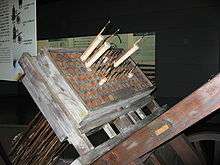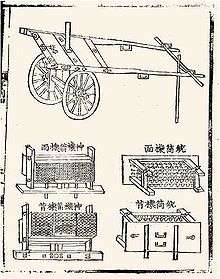Hwacha
| Hwacha | |
 A hwacha model at the Seoul War Memorial. | |
| Korean name | |
|---|---|
| Hangul | 화차 |
| Hanja | 火車 |
| Revised Romanization | Hwacha |
| McCune–Reischauer | Hwach'a |
A hwacha or hwach'a (화차; 火車) (fire cart)[1] was a multiple rocket launcher developed by Koreans and deployed in the defence of Korea against Japanese invasion in the 1590s.[2] It had the ability to fire up to 200 singijeon, a type of fire arrow rocket, at one time.[3] The hwacha consisted of a two-wheeled cart carrying a board filled with holes into which the singijeon were inserted.[4]
Some East Asian historians believe this technological breakthrough, alongside the turtle ship in the mid-16th century, had a distinctive effect during the Imjin War.[5] Today, hwachas appear in Korean museums, national parks, and popular culture.
History

Long before the development of the hwachas, China imposed severe restrictions on exporting gunpowder, fiercely guarding a military asset. Yet gunpowder weapons were key to the Koreans in maintaining a predominant navy in the Sea of Japan (East Sea) to protect fishermen and merchants against the increasing numbers of invading Japanese and Wokou pirates.
In response, there was an effort by Koreans to develop gunpowder on their own. Korea first began production of gunpowder during the period 1374–76.[6] In 1377 a Korean scholar named Choe Mu-seon discovered a way to obtain it by extracting potassium nitrate from the soil and subsequently invented the juhwa, Korea's very first rocket.[7] Further developments led to the birth of the family of singijeons.
The hwacha was a further development from the juhwa and the singijeon. The first hwacha was developed in Korea in 1409 during the Joseon Dynasty by several Korean scientists, including Yi Do (이도, not to be mistaken for Sejong the Great, even though their names sounds similar) and Choi Hae-san (최해산, son of Choe Museon).[8][9] Stronger and more effective hwachas were made in 1451 under the decree of King Munjong, by king himself and his yonger brother Pe. ImYung(Yi Gu, 임영대군 이구). This "Munjong Hwacha" that are well-known type for nowadays could fire 100 rocket arrows or 200 small Chongtong bullets at one time with changeable modules. At the time, 50 units were deployed in Hanseong (present-day Seoul), and another 80 on the northern border. By the end of 1451, hundreds of hwachas were deployed throughout the peninsula.[8][10]
Imjin wars (1592–1598)
Hwachas saw action most extensively against the Japanese during their invasions of Korea. The hwachas were mostly placed in fortresses or citadels,[5] and used defensively. They proved to be powerful in many battles, and were most prominent in the Battle of Haengju, in which 3,400 Koreans repelled 30,000 Japanese with the help of 40 hwachas. The Japanese samurai infantry, especially in the Battle of Haengju, typically advanced in dense formations, presenting ideal targets for the hwacha.[5]
Hwachas were also used on panokseons under the navy of Admiral Yi Sun-sin to attack Japanese ships from a distance.
Components

The hwacha's structure was very similar to a handcart, with a mobile wooden launchpad on the top containing 100 to 200 cylindrical holes, into which igniters like those of the sajeonchongtong (사전총통) were placed.[8]
The ammunition, similar to the ancient Chinese fire arrows, consisted of a 1.1 m long arrow with the addition of a gunpowder-filled paper tube attached to the shaft just below the head. Approximately 100 projectiles were loaded and launched in one volley,[8] and had a range of up to 2000 m.
One variant had 5 rows of 10 gun barrels in the launchpad, each of which could fire a bundle of four arrow-like projectiles.
The back side of the hwacha featured two parallel arms that allowed the operator to push and pull the machine, and a vertical strip designed for in-line attacks or stand ground-sentry positions.[11]
The wagon-like wheels were usually fastened by wood pivots and iron axles. In order to reduce friction between the wheels and the axles, tar oil was used.[12]
Hwachas were usually made of pine wood, although there are some versions made of oak. The ropes used were usually made of hemp.
The Korean army included siege engineers and blacksmiths in order to make repairs to the hwacha in case of damage due to poor road conditions, bad weather, or battle.[11]
Projectiles

Unlike the cannons or mortars used in Western warfare during Middle Ages and the 16th century, which required heavy iron balls, hwachas fired arrows which were thin and light, making it an easy-to-maneuver siege weapon.[12]
The holes in the hwacha's launching array ranged in diameter from 2.5 to 4 cm, which allowed thin Gungdo bow-like arrows to be fired and also admitted sajeonchongtong class igniters placed in the back side of the shooting board.[12]
Singijeon-class projectiles were small arrows designed by Korean siege engineers specifically to be used in hwachas. Called so (소), or "small", they possessed a pouch of black powder attached in the bottom near to the fletching section.[12] Besides the singijeon-class projectiles, hwacha could also fire 100 steel-tipped rockets.[13]
Because of the large numbers of arrows fired from hwachas and the widespread damage of its attack, a dense formation presented an ideal target for hwachas.
Ballistics and range
The trajectory of the so projectiles was fairly flat and – like other spinning projectiles – affected by the Magnus effect. Operators used to fire the weapon at an elevation of nearly 45° to maximise range. Adverse weather conditions (wind, humidity, rain) during a battle generally limited their striking distance to about 100 m.
Hwachas' range could be extended if the siege weapon was situated on a hill or other elevated place. Singijeon arrows from that position had a range of about 500 yards (≈450 meters).[14]
A 15th-century account from the Annals of Joseon Dynasty tells us of an experiment in which the singijeon fired from a hwacha completely pierced a scarecrow armed with a suit of armour and shield, at the range of 80 paces (about 100 m).
Usage

Hwachas were mostly used in a defensive manner; however, some Western and East Asian historians have concluded that in some cases they were used offensively in sea-to-land attacks and in naval warfare as well, particularly in the Battle of Noryang Point, during the Imjin wars in 1598.[14]
Hwachas were usually carried to battle highly escorted. Once the army settled down in trenches or base camps, the operators would disassemble the siege weapon by placing the launching array on the top. Hwachas were similar to European trebuchets to transport, and required assembling before usage. All the pieces featured similar characteristics and the mobile launching array could be unpacked and easily placed on the wood frame on the top of cart.[14]
Once a hwacha was set up for combat, the operators would use the gunpowder stored in a boot-like bag tied on each igniter to be used for each hole on the machine. After that, the operators were able to load the hwacha with arrows or iron spikes and be ready to shoot. To do so, they stepped back, covered their ears, and pulled the rope for each igniter.[12]
At sea, manoeuvres were slightly different and more complex because the operator would need to find a proper and stable place to fire. Some Hwacha operators preferred to be on the rowers' deck where they were able to shoot from the windows, while others preferred to be on the main deck so they could shoot at the sails of the enemy ships. These kind of manoeuvres were particularly seen on Korean Panokseon warships.[12]
See also
- Japanese invasions of Korea (1592-1598)
- Singijeon
- Fire arrow
- Ribauldequin
- Huolongjing
- Katyusha, a multi-barrel Soviet rocket launcher used in World War 2.
- Hwacha on MythBusters
- Type 63 multiple rocket launcher and RPU-14 - modern versions of light MRL
References
- ↑ Royal Asiatic Society of Great Britain and Ireland. Korea Branch (2002). Transactions of the Royal Asiatic Society, Korea Branch. 77–80. The Branch. Retrieved 2012-05-30.
- ↑ R. G. Grant (2011). Commanders. Dorling Kindersley Ltd. p. 117.
- ↑ Kim, Myung Oak; Jaffe, Sam (2010). The new Korea: an inside look at South Korea's economic rise. AMACOM Div American Mgmt Assn. p. 149. ISBN 978-0-8144-1489-7. Retrieved 2012-05-30.
- ↑ Michael E. Haskew; Christer Joregensen; Eric Niderost; Chris McNab (2008). Fighting techniques of the Oriental world, AD 1200–1860: equipment, combat skills, and tactics. Macmillan. p. 201. ISBN 978-0-312-38696-2. Retrieved 2012-05-30.
- 1 2 3 Ki-Baik, Lee; Schultz, Edward J. (September 2005). New History of Korea (2nd ed.). US: Harvard University Press. p. 518. ISBN 978-0-674-61576-2.
- ↑ Seoul National University-College of Humanities-Department of History (2005-04-30). "History of Science in Korea". Vestige of Scientific work in Korea. Seoul National University. Retrieved 2006-07-27.
- ↑ Korean Broadcasting System-News department (2005-04-30). "Science in Korea". Countdown Begins for Launch of South Korea’s Space Rocket. Korean Broadcasting System. Retrieved 2006-07-27.
- 1 2 3 4 Doe, John (2005-04-30). "Daum Encyclopedia History of Korea". Hwacha. Open Publishing. Retrieved 2015-11-15.
- ↑ "Article of Oct 18, Taejongsillok of Annals of Joseon Dynasty book 18 (click 태종 for view)". National Institute of Korean History. 1409. Retrieved 2015-11-15.
- ↑ "Articles of 1451, Munjongsillok of Annals of Joseon Dynasty (from book 5 to 9, click 문종 for view)". National Institute of Korean History. 1451. Retrieved 2015-11-15.
- 1 2 Rees, David (July 2001). Korea: An Illustrated History (2nd ed.). US: Hippocrene Books. p. 147. ISBN 978-0-7818-0873-6.
- 1 2 3 4 5 6 Reynolds, Wayne (November 2001). Siege Weapons of the Far East: Ad 612–1300 (1st ed.). US: Osprey Publishing. p. 48. ISBN 978-1-84176-339-2.
- ↑ Turnbull, Stephen. Samurai Invasion. Sterling. p. 149.
- 1 2 3 Nossov, Konstantin; Vladimir Golubev (December 2005). Ancient and Medieval Siege Weapons: A Fully Illustrated Guide to Siege Weapons and Tactics (1st ed.). US: Oxford University Press. p. 352. ISBN 978-0-19-820639-2.